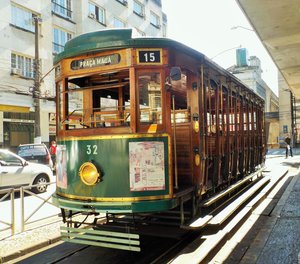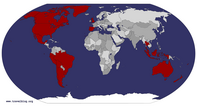Advertisement
Published: June 20th 2015

 A Santos Streetcar
A Santos Streetcar
This one was made in Scotland!Thursday 18
th June 2015
The problem with long-distance bus journeys in a country where sunsets come early, is that one arrives in unknown territory in the dark. Our bus yesterday from Sao Sebastiao brought us to Santos at dusk, so by the time we had got a taxi to our hotel, it was dark. The receptionist spoke just a few words of English, no Spanish at all and we failed to discover where we could find any tourist information so that we could see the sights today. Therefore, this morning, after breakfast, we headed for the beach and just walked along the promenade for two or three kilometres and then we found an old streetcar converted into a Tourist Information Centre. The beach is enormous; seven kilometres of wide golden sands fringed by palms and five kilometres of elegant cultivated gardens. These gardens are the biggest beachside gardens in the world and they are magnificent as is the beach. Copacabana and Ipanema eat your hearts out! A lovely helpful girl in the Tourist Information Centre, who spoke excellent English, gave us sound advice about how to get around the city. Forget tourist tours, they only operate

 Coffee Museum
Coffee Museum
In the old Coffee Exchangeat weekends at this time of the year and she assured us that the local transport is better anyway. We left there armed with two decent city maps and following her directions, found the trolley bus stop which took us to the historic old town. All journeys, irrespective of length cost R$3.75 (1.07€ or £0.77).
The city of Santos sits on an island, with water on the north, east and southern sides and natural rainforest to the west. The other side of the forest is the town of Sao Vicente, which is also the name of the whole island. Santos old town is located on the northern side of a hill called Monte Serrat (by the oldest docks) and the new town is the other side of the hill, on the south by the beach. A funicular railway takes visitors from the old town up to the top of Monte Serrat, for panoramic views across the city. We ran out of time today so we shall do this another day whilst we are here. The reason we ran out of time will be explained shortly. Once in the old town we boarded a streetcar (tram) to take
us on a tour of the neighbourhood, enabling us to pinpoint where to walk back to. Our three targets were to be the Coffee Museum and the Pelé Museum in the morning, then the Monte Serrat funicular railway after lunch. It proved impossible to get John out of the Pelé Museum even to eat lunch, let alone go up the Monte Serrat. John was overcome with emotion, worshipping his football hero, so the time spent there was worth it. None of the restaurants were serving lunch when we finally came out of the museum at 4.00 p.m. however, so we had to starve until dinner in the evening!
The “Museu do Café” is a “must see” tourist attraction in Santos. The museum is housed in the former Official Coffee Exchange building, where the coffee magnates sat in the splendid Auction Room from 1922 until the Exchange transferred to Sao Paulo in the 1950s. Here in the Auction Room, the negotiations for setting the daily price for bags of coffee were held.
Coffee production came relatively late to Brazil, in the eighteenth century (1727). Coffee came originally from Ethiopia, then its cultivation spread through the
Middle East (Arabica coffee) before the Dutch brought it to Europe as well as to the Dutch East Indies, notably Java. From Europe it was taken, by both the Dutch and the French, to the Caribbean and from there the Portuguese introduced the plant to Brazil. Brazil´s political, economic and cultural development is closely linked with the coffee trade. It is a great exhibition and we really enjoyed our visit. We bought some coffee beans to take home with us. They grind up beans for sale there, and after a bit of a struggle, we persuaded the guy in the museum shop to sell us some beans. He was a bit perplexed that we didn´t want them ground, but they will survive better in John´s rucksack as beans, rather than powder, so that we can grind them to enjoy freshly ground when we get back to Spain. We do hope they are good, because they were expensive compared to the coffee we buy at home. These beans are supposed to be the strongest, richest and most aromatic Grade One Brazilian beans, which cost R$100 per kilo. We bought just 250 grams for R$25, which is just over 7€. Next stop
was the Pelé Museum.
Pelé is not just a legend in Brazil, he is revered as a god. As Joao Saidanha, the Brazilian football commentator and manager, at the 1966 World Cup in England said…
“Brasil es famoso por el fútbol y Pelé es más famoso que Brasil”
(“Brazil is famous for its football and Pelé is more famous than Brazil”)
Given these sentiments, it is not surprising that the “Museu Pelé” is housed in a beautiful building, the Valongo Mansions. The nineteenth century Valongo Mansions, built as two separate buildings interlinked by a horizontal ground-floor structure, was the grandest construction along the coast of the state of Sao Paulo. The first railway station in the state was built opposite the mansions. Constructed in 1867 and 1872, they housed the companies and business of the coffee industry. Coffee, it is said, made Brazil, generating its economy and progress and the grand Valongo Mansions epitomised this abundant prosperity. By the late twentieth century, the mansions had fallen into decay, after being gutted by fires. They were recovered from dereliction, in 2014, at huge
expense, to house the Pelé Museum. It is a mark of how important Pelé has been to the city, indeed the nation, that such an ambitious and expensive renovation was initiated, so that an iconic building should house the memorabilia and tributes of a national hero. The result is magnificent, an elegant building tastefully restored and adapted to provide an impressive museum.
Friday 19
th June 2015
The climate in the Brazilian winter is changeable. Yesterday, the sea was blue, the sun shone in a clear blue sky and the temperatures reached thirty degrees. Today, the wind bent the palm trees over, the rain lashed down throughout most of the day and the temperatures plummeted to fifteen degrees; quite a contrast. So, we exchanged our flip flops for hiking boots, grabbed our cagoules and headed off to the “Orquidea” which is close to where we are staying.
Entry to the Orchid Park was free, because the orchids bloom in the summer, only a few small ones are in bloom now. It is an interesting place, however, being a botanical garden as well, and it is inhabited by the Brazilian Agouti.
The Agouti are unusual animals, weighing between three and six kilo, they look like a cross between a prairie dog and a tail-less squirrel and eat fruits, roots and seeds. They live all over the gardens, roaming freely as do tortoises and there are fish and turtles in the lake. Numerous birds visit the area and there are also large aviaries housing parrots, owls and water fowl, including some brown white-footed Boobies. There are a few endangered animal species in cages, some monkeys and a wildcat. Whether they are there for conservation and breeding, or just for the public to look at, we are not sure. The monkeys looked rather unhappy. Although the cages are quite large, it isn´t the same as seeing them free in the jungle!
Leaving the Orchid Park, we set off to walk along the beachside gardens but before long the heavens opened so we retreated to a bar. After lunch we headed back to the hotel and the rain kept us there throughout the afternoon. The afternoon was notable, however, because we discovered cashew juice. We are not sure whether or not it is available in Europe, but it is a very
popular drink here in Brazil. A lot of cashew nuts are grown in Brazil, as well as Brazil nuts of course. The cashew, like the almond, is not technically a nut, but rather it is a seed of the cashew apple and the juice, rich in vitamin C, is delicious; cannot say much for the food in Brazil, but the cashew juice and the nuts are great!
Saturday 20
th June 2015
Today it was sunny again and being a Saturday, the “Hop-on-hop-off” buses were in operation, so we spent a full day sightseeing. The only part of the route avoided by our driver was the area around the football stadium, because Santos were playing at home. So, we finally got to go up Monte Serrat on the little funicular railway, which has been running since 1927. It was worth the wait because the 360 degree views from the top showed us the whole city. The hill, like the Caribbean island of Montserrat, is of course named after Montserrat in Spain, in Catalonia. Back in the days when both Portugal and Brazil were ruled by Spain, one of the Governors of Brazil was Catalonian and
so he named the hill after the “Serrated Mountain” the Montserrat in Spain.
Santos is a lovely city, clean, hospitable and elegant. Up until the Twentieth Century, it only occupied the small area north of Monte Serrat, where the first village was settled by Portuguese sailors, then the elegant buildings like the cathedral, opera house, coffee exchange and the many mansions, were built by the coffee barons, making Santos into a city. Still, however, the south was left as marshland until in the early part of the last century, the famous Santos canals, which divide the city into distinct neighbourhoods, were constructed, so that sea water could flow through the city thus cleansing the swamps. By 1905 when the plans were drawn up for the building of the canals, the city was suffering severely from a series of Yellow Fever outbreaks, which had reached epic proportions. Mosquitos here in Brazil still carry the Yellow Fever bacteria, but the risk of catching this fatal disease is greatly reduced to what it was one hundred years ago. Still, however, travellers have to have the Yellow fever vaccine, which we have had, because we shall have to show our vaccine

 Granite sculpture of a wood nymph
Granite sculpture of a wood nymph
Moved to the Orchid Park from the city plaza in 1959 due to complaints about her nudity!!!cards to cross the border into Argentina in the next week or so, and then again to get back into Brazil.
This evening we are once again packing the rucksacks because tomorrow morning we are catching the 09.00 bus south to Curitiba. By the time we get to Curitiba we shall have journeyed about 850 kilometres by road from Rio, with another 650 to go to the Iguaçu Falls. It’s proving to be a great journey!
Advertisement
Tot: 0.209s; Tpl: 0.014s; cc: 12; qc: 30; dbt: 0.1484s; 1; m:domysql w:travelblog (10.17.0.13); sld: 2;
; mem: 1.1mb






















